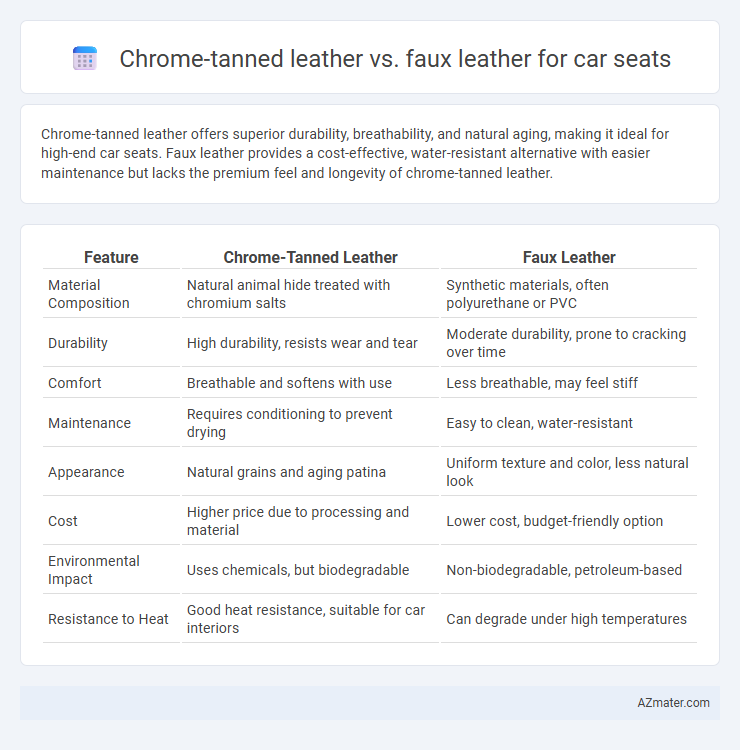Chrome-tanned leather offers superior durability, breathability, and natural aging, making it ideal for high-end car seats. Faux leather provides a cost-effective, water-resistant alternative with easier maintenance but lacks the premium feel and longevity of chrome-tanned leather.
Table of Comparison
| Feature | Chrome-Tanned Leather | Faux Leather |
|---|---|---|
| Material Composition | Natural animal hide treated with chromium salts | Synthetic materials, often polyurethane or PVC |
| Durability | High durability, resists wear and tear | Moderate durability, prone to cracking over time |
| Comfort | Breathable and softens with use | Less breathable, may feel stiff |
| Maintenance | Requires conditioning to prevent drying | Easy to clean, water-resistant |
| Appearance | Natural grains and aging patina | Uniform texture and color, less natural look |
| Cost | Higher price due to processing and material | Lower cost, budget-friendly option |
| Environmental Impact | Uses chemicals, but biodegradable | Non-biodegradable, petroleum-based |
| Resistance to Heat | Good heat resistance, suitable for car interiors | Can degrade under high temperatures |
Overview of Chrome-Tanned Leather and Faux Leather
Chrome-tanned leather, treated with chromium salts, offers superior durability, softness, and resistance to wear, making it a premium choice for car seats. Faux leather, crafted from synthetic materials such as polyurethane or PVC, provides a cost-effective, animal-friendly alternative with easy maintenance and water resistance. Both materials differ significantly in breathability, aging characteristics, and environmental impact, influencing comfort and longevity in automotive interiors.
Key Differences in Material Composition
Chrome-tanned leather is derived from animal hides treated with chromium salts, enhancing flexibility and durability while retaining natural grain patterns; it offers breathability and develops a unique patina over time. Faux leather, composed of synthetic materials such as polyurethane or polyvinyl chloride (PVC), mimics real leather's appearance but lacks the organic texture and aging characteristics, providing a more uniform and water-resistant surface. The key difference lies in material origin--natural protein fibers versus man-made polymers--which affects comfort, wear resistance, and environmental impact in car seat applications.
Durability and Longevity Comparison
Chrome-tanned leather offers superior durability for car seats due to its chemical processing, which enhances resistance to wear, moisture, and temperature fluctuations, ensuring long-lasting performance. Faux leather, while more affordable and easier to maintain, typically lacks the same longevity and tends to crack or peel over time under frequent use. Choosing chrome-tanned leather guarantees extended durability and a premium feel that withstands daily automotive stress better than synthetic alternatives.
Comfort and Feel: User Experience
Chrome-tanned leather offers superior breathability and softness, enhancing comfort by adjusting to temperature changes and reducing sweat buildup during long drives. Faux leather, while durable and easier to maintain, often lacks the same natural texture and breathability, sometimes resulting in a less comfortable seating experience. Users frequently report that chrome-tanned leather provides a more luxurious feel, improving overall satisfaction in vehicle interiors.
Aesthetic Appeal and Customization Options
Chrome-tanned leather offers a rich, natural texture and patina that enhances the luxurious aesthetic appeal of car seats, providing a timeless elegance unmatched by synthetic materials. Faux leather, available in a wide range of colors and finishes, allows for extensive customization options tailored to personal style preferences and can be easily maintained for a consistent look. While chrome-tanned leather develops a unique character over time, faux leather provides versatile, cost-effective design choices without sacrificing visual impact.
Maintenance and Cleaning Requirements
Chrome-tanned leather car seats require regular cleaning with a damp cloth and conditioning every 3 to 6 months to maintain suppleness and prevent cracking. Faux leather seats are easier to maintain, needing only mild soap and water for cleaning, and they resist stains and wear better over time without the need for conditioning. Both materials benefit from prompt spill cleanup, but chrome-tanned leather demands more specialized care to preserve its natural texture and durability.
Environmental Impact and Sustainability
Chrome-tanned leather in car seats involves heavy metal chemicals like chromium, which pose significant environmental pollution risks during tanning processes and waste disposal. Faux leather, made primarily from synthetic materials such as polyurethane or PVC, contributes to microplastic pollution and relies on fossil fuels, raising concerns about carbon footprint and long-term sustainability. Sustainable alternatives include vegetable-tanned leather and bio-based faux leather, which aim to reduce toxic waste and reliance on non-renewable resources.
Cost Analysis: Upfront and Long-term
Chrome-tanned leather seats typically involve higher upfront costs ranging from $500 to $2,000 per set due to the complex tanning process and premium material quality. Faux leather alternatives can reduce initial expenses by 30-60%, making them attractive for budget-conscious consumers, but may incur higher long-term costs due to premature wear and replacement every 3 to 5 years. Considering maintenance, chrome-tanned leather offers superior durability and aging properties, potentially lowering costs related to seat repairs and restorations over a vehicle's lifespan.
Health and Safety Considerations
Chrome-tanned leather contains chromium salts that may cause allergic reactions or respiratory issues, posing health risks in car seats, especially for sensitive individuals. Faux leather, often made from PVC or polyurethane, avoids these heavy metals but can emit volatile organic compounds (VOCs) that affect indoor air quality and cause irritation. Choosing materials with low VOC emissions and avoiding harmful chemicals enhances safety and ensures a healthier car seat environment.
Final Verdict: Choosing the Right Material for Car Seats
Chrome-tanned leather offers superior durability, breathability, and a premium feel, making it ideal for luxury car seats that require longevity and comfort. Faux leather provides a budget-friendly, easy-to-maintain alternative with enhanced resistance to stains and fading, suitable for those prioritizing affordability and low upkeep. Selecting the right material depends on balancing long-term investment benefits of chrome-tanned leather against the cost-effectiveness and practicality of faux leather.

Infographic: Chrome-tanned leather vs Faux leather for Car seat
 azmater.com
azmater.com